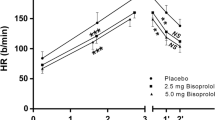Abstract
Objective: The effect of β2-adrenoceptor agonist-induced hypokalaemia on cardiac arrhythmias might be exacerbated during exercise, especially in patients with more compromised airway function.
Methods: To evaluate the effect of β2-adrenoceptor agonists on plasma potassium and cardiopulmonary function during exercise, two identical submaximal treadmill exercise tests were performed, at least 48 h apart, by 13 patients with moderate to severe COPD (11 men and 2 women, mean age 66 y, mean FEV1/FVC ratio 48.9 (2.8)%) 30 min after they had received nebulised fenoterol or salbutamol (2 mg). The experiment was done as a randomised, double-blind, crossover trial after an initial baseline study with vehicle (0.45% saline). Plasma potassium concentration, spirometry and the degree of breathlessness (Borg scale) were measured before treatment and immediately after exercise; oxygen saturation, QTc interval and cardiac rhythm were monitored continuously before, during and for 30 min after exercise.
Results: After the saline control, exercise caused an increase in Borg rating (of 4.9), a premature ventricular contractions (VPC) (2.8 beats/min), and a fall in oxygen saturation (-6.7%), but no significant change in plasma potassium (+0.04 mEq·dl−1), FEV1 or QTc interval. Inhalation of fenoterol and salbutamol did not affect QTc interval, Borg scale or VPC frequency at rest, but significantly increased the duration of exercise undertaken to reach the submaximal levels (786 s, versus 783 s) compared to the vehicle control. Following exercise, plasma potassium fell after fenoterol by 0.2 mEq·dl−1 and it increased after salbutamol by 0.1 mEq·dl−1 compared to baseline levels. Plasma potassium after exercise was significantly lower after fenoterol (3.2 mEq·dl−1) compared to the saline control (3.7 mEq · dl−1) and salbutamol (3.6 mEq · dl−1). Neither fenoterol nor salbutamol had any significant effect on the change in FEV1, oxygen saturation, Borg scale, frequency of VPCs or QTc interval during or after exercise compared to the saline control.
Conclusion: When compared to salbutamol 2 mg, fenoterol 2 mg caused more marked hypokalaemia but no significant difference in cardiopulmonary response in patients with COPD during exercise.
Similar content being viewed by others
References
Crane J, Pearce N, Flatt A (1989) Prescribed fenoterol and death from asthma in New Zealand. Lancet 1: 917–922
Spitzer WO, Sussia S, Ernst P, Horwitz RI, Habbick B, Cockcroft D, Boivin JF, McNutt M, Buist AS, Rebuck AS (1992) The use of β-agonist and the risk of death and near death from asthma. N Engl J Med 326: 501–506
Flatt A, Crane J, Puride G, Kwong T, Beasley R, Burgess C (1990) The cardiovascular effects of beta adrenergic agonist drugs administered by nebulisation. Postgrad Med J 66: 98–101
Bremner P, Burgess C, Beasley R, Woodman K, Marshall S, Crane J, Pearce N (1992) Nebulized fenoterol causes greater cardiovascular and hypokalaemic effects than equivalent bronchodilator doses of salbutamol in asthmatics. Respir Med 86: 419–423
Struthers AD, Reid JL (1984) The role of adrenal medullary catecholamines in potassium homeostasis. Clin Sci 66: 377–382
Kuschinsky W, Wahl M (1977) Interactions between perivascular norepinephrine and potassium or osmolarity on pial arteries of cats. Microvasc Res 14: 173–180
Paterson DJ (1992) Potassium and ventilation in exercise. J Appl Physiol 72: 811–820
Siegel G, Schneider W (1981) Anions, cations, membrane potential, and relaxation. In: Vanhoutte PM, Leusen I (ed) Vasodilatation. Raven Press, New York, pp 285–298
Laso FJ, Gonzalez-Buitrago JM, Ruiz CM, Castro S (1991) Hormonal regulation of potassium shifts during graded exhausting exercise. Eur J Appl Physiol 62: 292–296
Young DB, Srivastava TN, Fitzovich DE, Kivlighn SD, Hamaguchi M (1992) Potassium and catecholamine concentrations in the immediate post exercise period. Am J Med Sci 304: 150–153
Coplan NL, Gleim GW, Nicholas JA (1989) Exercise-related changes in serum catecholamines and potassium: effect of sustained exercise above and below lactate threshold. Am Heart J 117: 1070–1075
Wong CS, Pavord ID, Williams J, Britton JR, Tattersfield AE (1990) Bronchodilator, cardiovascular, and hypokalaemic effects of fenoterol, salbutamol, and terbutaline in asthma. Lancet 336: 1396–1399
American Thoracic Society (1987) Standards for the diagnosis and care of patients with chronic obstructive pulmonary disease (COPD) and asthma. Am Rev Respir Dis 136: 225–244
Douglas NJ, Davidson I, Sudlow MF, Flenley DC (1979) Bronchodilatation and the site of airway resistance in severe chronic bronchitis. Thorax 34: 51–56
American Association for Respiratory Care (1992) AARC Clinical Practice Guideline: bronchial provocation. Respir Care 37: 902–906
McPherson SP, Spearman CB (1990) Humidifiers and neubulizers. In: Respiratory therapy equipment. Mosby US, pp 79–107
Phipps PR, Gonda I, Anderson SD, Bailey D, Bautovich G (1994) Regional deposition of saline aerosols of different tonicities in normal and asthmatic subjects. Eur Respir J 7: 1474–1482
Burgess CD, Flatt A, Siebers R, Crane J, Beasley R, Purdie G (1989) A comparison of extent and duration of hypokalaemia following three nebulized β2-adrenoceptor agonists. Eur J Clin Pharmacol 36: 415–417
Goldman MJ (1986) Definitions of electrocardiographic configurations. In: Principles of clinical electrocardiography. Lange Medical Publications, California, pp 23–28
Burdon JGW, Juniper EF, Killian KJ, Hargreave FE, Campbell EJM (1982) The perception of breathlessness in asthma. Am Rev Respir Dis 126: 825–828
Dimsdale JE, Hartley LH, Guiney T, Ruskin JN, Greenblatt D (1984) Postexercise peril. JAMA 251: 630–632
Windom HH, Burgess CD, Siebers RWL, Purdie G, Pearce N, Crane J, Beasley R (1990) The pulmonary and extrapulmonary effects of inhaled β-agonists in patients with asthma. Clin Pharmacol Ther 48: 296–301
Tandon MK (1980) Cardiopulmonary effects of fenoterol and salbutamol aerosols. Chest 77: 429–431
Goldie RG, Spina D, Henry PJ, Lulich KM, Paterson JW (1986) In vitro responsiveness of human asthmatic bronchus to carbachol, histamine, beta-adrenergic agonists and theophylline. Br J Clin Pharmacol 22: 669–676
Author information
Authors and Affiliations
Rights and permissions
About this article
Cite this article
Yang, C.T., Lin, H.C., Lin, M.C. et al. Effect of β2-adrenoceptor agonists on plasma potassium and cardiopulmonary responses on exercise in patients with chronic obstructive pulmonary disease. Eur J Clin Pharmacol 49, 341–345 (1996). https://doi.org/10.1007/BF00203774
Received:
Accepted:
Issue Date:
DOI: https://doi.org/10.1007/BF00203774




